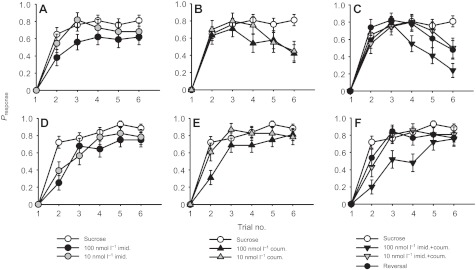Fig. 2.

Rates of acquisition during olfactory conditioning (massed conditioning A–C, spaced conditioning D–F) are affected by pesticide treatment. Treatment with 100 nmol l−1 imidacloprid (A) and 10 and 100 nmol l−1 coumaphos (B) reduced the rate of acquisition (response probability Presponse). (C) Treatment with imidacloprid plus coumaphos had a similar effect on acquisition to that produced by 100 nmol l−1 coumaphos alone. Bees allowed to recover from the 100 nmol l−1 treatment did not differ from the control (sucrose). During spaced conditioning, 10 and 100 nmol l−1 imidacloprid (D) and 100 nmol l−1 coumaphos (E) reduced the rate of acquisition. (F) The 100 nmol l−1 dose of imidacloprid plus coumaphos strongly reduced the rate of acquisition. Bees allowed to recover from the 100 nmol l−1 combined imidacloprid plus coumaphos treatment (i.e. reversal) did not differ from the control. Sample sizes and pairwise comparison statistics for all treatments and doses are shown in Table 2. Note: the control group is the same for A–C and for D–F.
